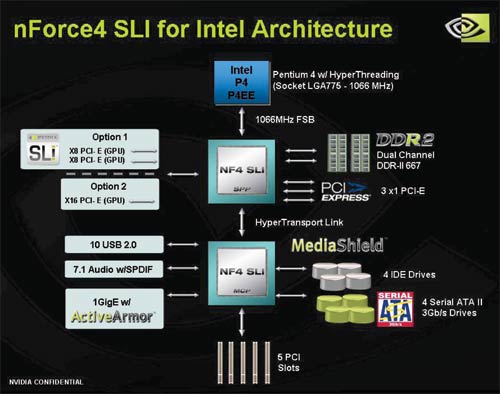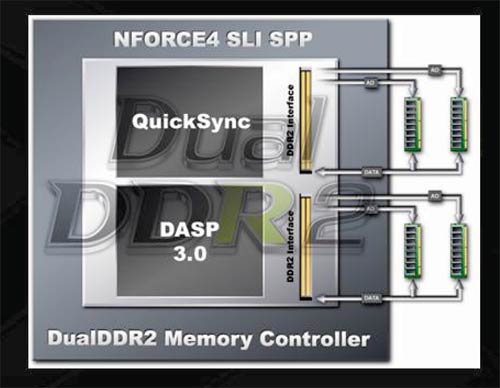Dual Core Intel Platform Shootout - NVIDIA nForce4 vs. Intel 955X
by Anand Lal Shimpi on April 14, 2005 1:01 PM EST- Posted in
- CPUs
NVIDIA's nForce4 SLI Intel Edition Chipset
As we've indicated in the past, NVIDIA's first Intel chipset is very similar to their nForce4 AMD chipset, with a couple of exceptions. For starters, the Intel Edition chipset is made up of two chips, compared to the AMD chipset's one. The reasoning is simple: with AMD's architecture, NVIDIA needn't include a memory controller in their chipset, which cuts down on overall die size quite a bit. With the Intel Edition, we see the first new memory controller that NVIDIA has introduced since nForce2.

Remember DASP? NVIDIA's Dynamic Adaptive Speculative Pre-Processor is back in nForce4 Intel Edition, but this time around, the competition is much stronger. DASP is a hardware pre-fetch engine that resides within the memory controller and attempts to pre-fetch data into a small amount of cache on the chipset, which NVIDIA's algorithms determine will be used by the CPU in the future. Intel has a similar technology in their 955X chipset, although it's not something they have branded or marketed. Depending on how aggressive NVIDIA's DASP is, it could make good use of the extra memory bandwidth offered by its dual channel DDR2-533/667 memory bus.

NVIDIA also boasts a dedicated address bus per DIMM slot with the nForce4; however, this seems to be a feature also supported by Intel, so there isn't much advantage over the competition here.
In their final memory controller optimization, NVIDIA's QuickSync claims to be able to reduce memory latency when operating in multiple clock domains (e.g. 800MHz FSB, but 533MHz memory bus). Later in this article, we'll find out exactly how aggressive NVIDIA's memory controller truly is.
The nForce4 SLI Intel Edition chipset supports both 800 and 1066MHz FSBs, just like the 955X - however, NVIDIA also indicated that if Intel were to increase the FSB frequency, they would be ready.
Unlike the 955X, NVIDIA only supports 3 PCI Express x1 slots. However, NVIDIA does offer two PATA channels, compared to Intel's single PATA channel. NVIDIA also offers more USB 2.0 ports (10 vs 8). NVIDIA does not support Intel's HD Audio spec, so you're stuck with AC'97 on the nForce4 SLI.










96 Comments
View All Comments
segagenesis - Thursday, April 14, 2005 - link
#15 - Score: -1, TrollWhy are you here then? Hell, you cant even read I guess. I gave you a link talking about heat output when you said it was "opinion" when it was stated Intel runs hotter. I can tell you that from fact from the 25 prescotts sitting in a lab here and when they are all running the A/C better be running too!
Why dont you come up with some facts yourself instead of insulting both the site and others?
Questar - Thursday, April 14, 2005 - link
#11,What makes you think I would care about "a huge landslide of flames regarding your post in this comment section"?
99% of the people on this site are ignorant cattle without the ability to think for themselves. They are here as part of a communal circle jerk over AMD cpu's. I care as much for their thoughts as I care about the thoughts of the cow that gets slaughtered for my dinner.
jimmy43 - Thursday, April 14, 2005 - link
I see we got an Intel fanboy posting in the forums :]Questar - Thursday, April 14, 2005 - link
#10,I see no information in your link that #8's argument. He specifically said that an A64 is faster than Intel in all applications except for video encoding. The link you provided actually proves him wrong, as there are other applications in which the comparable Intel CPU is faster, or the difference is insignificant between the two.
mlittl3 - Thursday, April 14, 2005 - link
Oops, sorry...correction"...release of the K8 architecture 8 years ago..." should read "...release of the K8 architecture 2 years ago..."
Sorry about that. AMD's 2nd year anniversary of the release of the Opteron is next Thursday where they will introduct dual core Opterons to the public. Can't wait.
mlittl3 - Thursday, April 14, 2005 - link
Oh my God!!! Questar where have you been?Go read all the reviews of Intel and AMD processors since the release of the K8 architecture 8 years ago. You have a lot of reading to do.
Don't give the editor-in-chief of a 8 million plus readership hardware review site advise about getting his facts straight. Anandtech receives and reviews hundreds and hundreds of hardware that you will never even dream of owning.
If a statement is made in a review from a site as reputable as Anandtech, it is not made lightly. You have all the right in the world to question it and seek a second opinion elsewhere, but it is COMMON knowledge among those reading CPU reviews over the last two years that AMD CPUs are faster in games and computational number crunching whereas Intel excels in audio and video encoding PERIOD.
You can easily explain these findings. Games and computational number crunching take low latency, high memory bandwidth to work well. Audio and video encoding need fast processor speeds.
Wait about five hours after the release of this review and you will soon be finding a huge landslide of flames regarding your post in this comment section.
Have fun! :)
PS. You must not read at all if you think anyone has found a performance advantage of PCI-E and DDR2 over AGP and DDR for current software applications. Not tomshardware, Hardocp, Xbitlabs, Anandtech, etc. have found a performance increase between AGP 8X vs. PCI-E 16x or DDR400 vs. DDR2400/533/667.
segagenesis - Thursday, April 14, 2005 - link
#9 - You havent been here long have you? Intel does have a performance advantage in encoding applications... but your claims of without proof to others?http://www.anandtech.com/cpuchipsets/showdoc.aspx?...
Umm yeah. Pay attention 007.
And why even claim AGP has no performance benefits over PCI? Ever heard of a shared bus (PCI)?
?LOGIC ERROR
READY.
Questar - Thursday, April 14, 2005 - link
#8,Without proof, it's your opinion. So, find some reviews that showed an Intel cpu being significantly slower than an equivalent A64 in all applications except video encoding.
I assume you are using an AGP video card. Why? It has no performance benefits over a PCI card. Or is FPS in a game the only way you measure perfomance?
n yusef - Thursday, April 14, 2005 - link
#5"Honestly, Intel processors and even the platform haven’t been interesting since the introduction of Prescott. They have been too hot and poor performers, not to mention that the latest Intel platforms forced a transition to technologies that basically offered no performance benefits (DDR2, PCI Express)."
Your opinion only, don't make this out to be fact.
That is pretty much fact. In all areas except encoding, they were worse performers than their competiton (Athlon 64). The extra heat sure didn't improve that either. As far as forcing DDR2 and PCI Express, when they didn't improve performance, you can't disagree with that.
radx - Thursday, April 14, 2005 - link
QuestarI'm happy you're not the one writing these reviews here at anandtech. :-)
Go Anand!